Weird but true that in all the years I’ve been writing about gin botanicals I’ve never actually seen the harvesting process for myself. Imagine my delight then when I was invited by Bombay Sapphire Gin to join a crew of top UK bartenders on a trip to Tuscany to look at how two core botanicals, juniper and orris, are grown and gathered.
One of the ways that Bombay Sapphire ensures the quality of its precious ingredients is that Master of Botanicals Ivano Tonutti takes immense trouble to form relationships with the local growers and harvesters – see Bombay Sapphire botanicals feature.
 Nothing about the cultivation of juniper and orris is remotely industrial –it’s all done by hand the way it has always been done usually in places where it would be impossible to introduce machinery anyway. Juniper berries for example grow wild at altitude and the best come from outside Florence in a microclimate situated between the sea and the Apennines.
Nothing about the cultivation of juniper and orris is remotely industrial –it’s all done by hand the way it has always been done usually in places where it would be impossible to introduce machinery anyway. Juniper berries for example grow wild at altitude and the best come from outside Florence in a microclimate situated between the sea and the Apennines.
On the first morning of our trip we set off up long winding roads to the hills 1800 metres above Arezzo. Hard to believe that it’s November. Instead of the cold and wet of Blighty we bask in the soft light and golden haze of the ancient Italian campagna in all its glory. Eventually we arrive at the house of the Pastorinis, a husband and wife team in their 80s who have the rights to harvest juniper on nearby common land.
As Ivano explained country folk like the Pastorinis are a dying breed: they make their living from the land, foraging and selling what grows wild as the seasons turn. Truffles were now over and it was time for juniper. Ivano: “This way of life is extremely hard work and the young people don’t want to do it, they want to go to the city. But it’s the only way to get the best juniper.”
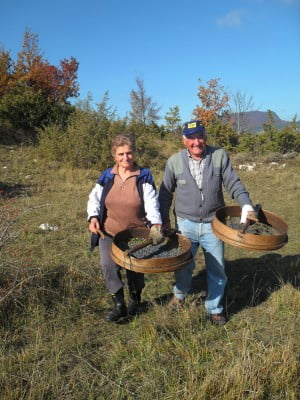 On their allotted patch the Pastorinis showed us how it’s done. Using hand-made wooden baskets with a stout wire mesh, a bit like a soil riddle, they position the baskets under the branches and carefully beat the bushes with a wooden stick so that the berries fall into their baskets. The trick here is to gather only the ripe blue-black berries leaving the green unripe ones to mature further until next year.
On their allotted patch the Pastorinis showed us how it’s done. Using hand-made wooden baskets with a stout wire mesh, a bit like a soil riddle, they position the baskets under the branches and carefully beat the bushes with a wooden stick so that the berries fall into their baskets. The trick here is to gather only the ripe blue-black berries leaving the green unripe ones to mature further until next year.
Here (courtesy of Camper English) is a short vid showing them in action:
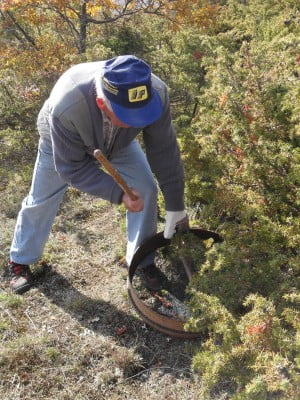
It is hard work and each harvester can pick only around 50 kilos of berries a day. Astonishingly the Pastorinis gather around two tonnes of berries between August and November every year. But a more invasive, faster method would run the risk of losing next year’s harvest and that would be a disaster. Juniper is slow growing and once the bushes reach a certain age they stop producing fruit. Local people know the ways of juniper and play their part in ensuring that the right conditions exist for the next generation.
A warming gin punch in the open air made by our inestimable Bombay hosts, Raj Negra and Ben Carlotti, and it was time for the gang to wend our way down the hill to our next stop, a smallholding in the Arno valley owned by Maurizio Vernini, another of Ivano’s secret army.
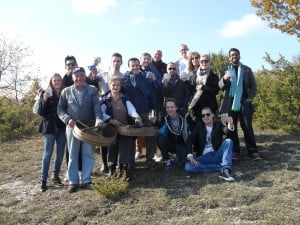 Here they grow grapes, olives and, crucially, fields of Florentine iris. Iris Fiorentina is grown commercially not for its flowers as some species of iris are, but for its’ rhizomes, underground root stems which, when dried, ground and aged, go into the still as orris root, one of the most important of the gin botanicals.
Here they grow grapes, olives and, crucially, fields of Florentine iris. Iris Fiorentina is grown commercially not for its flowers as some species of iris are, but for its’ rhizomes, underground root stems which, when dried, ground and aged, go into the still as orris root, one of the most important of the gin botanicals.
There’s a lot to do however before orris is ready for the still. First the plants are dug out of the ground with a long handled hoe in such a way as not to damage them. The rhizome chunks are carefully broken off leaving a small section attached to the plant to be replanted for next year’s harvest. The plants take three years to mature before they can be harvested so it’s crucial that the supply is maintained.
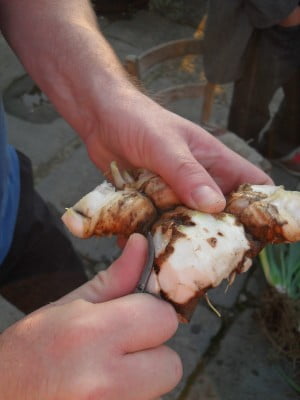 Then the rhizomes are peeled by hand using a lethal, very sharp, curved knife. There’s a real skill to this as we all found out when we tried to do it ourselves. The peeled lumps of orris are scrubbed in water and put on wire racks to dry for 15 days. At this stage they are virtually odourless. It takes months of ageing before they are able to release those delicate flavours of Parma violet and tea that are so distinctive in gin, particularly Bombay Sapphire.
Then the rhizomes are peeled by hand using a lethal, very sharp, curved knife. There’s a real skill to this as we all found out when we tried to do it ourselves. The peeled lumps of orris are scrubbed in water and put on wire racks to dry for 15 days. At this stage they are virtually odourless. It takes months of ageing before they are able to release those delicate flavours of Parma violet and tea that are so distinctive in gin, particularly Bombay Sapphire.
Describing it in this way gives the impression that there is some kind of production line operating here. In truth this is a genuine cottage industry and one can see the whole family, even children, sitting outside in the sunshine at the end of the day peeling and scrubbing just as Italian farmers might have done five hundred years ago.
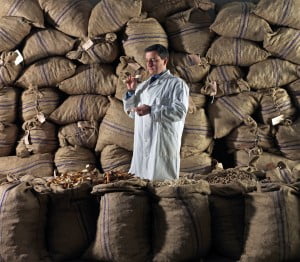 Tradition, love of the land, care for the environment, and respect for an age-old way of life – these are the values that underpin the gathering of the botanicals that make Bombay Sapphire Bombay Sapphire. Ivano and all gin distillers will tell you the same. In our modern world dominated by factory farming, chemical additives and genetically modified food let’s raise a glass to that. A glass of gin naturally.
Tradition, love of the land, care for the environment, and respect for an age-old way of life – these are the values that underpin the gathering of the botanicals that make Bombay Sapphire Bombay Sapphire. Ivano and all gin distillers will tell you the same. In our modern world dominated by factory farming, chemical additives and genetically modified food let’s raise a glass to that. A glass of gin naturally.




